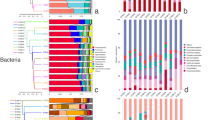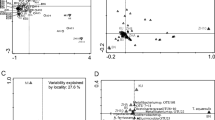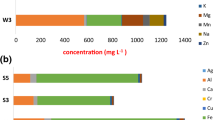Abstract
This data-intensive study investigated the delicate balance of niche and neutrality underlying microbial communities in freshwater ecosystems through comprehensive application of high-throughput sequencing, species abundance distribution (SAD), and the neutral community model (NCM), combined with species diversity and phylogenetic measures, which unite the traditional and microbial ecology. On the genus level, 45.10% and 41.18% of the water samples could be explained by the log-normal and Volkov model respectively, among which 31.37% could fit both models. Meanwhile, 55.56% of the sediment samples could be depicted by the log-normal model, and Volkov-fitted samples comprised only 13.33%. Besides, operational taxonomic units (OTUs) from water samples fit Sloan’s neutral model significantly better than those in sediment. Therefore, it was concluded that deterministic processes played a great role in both water and sediment ecosystems, whereas neutrality was much more involved in water assemblages than in non-fluidic sediment ecosystems. Secondly, log-normal fitted samples had lower phylogenetic species variability (PSV) than Volkov-fitted ones, indicating that niche-based communities were more phylogenetically clustered than neutrally assembled counterparts. Additionally, further testing showed that the relative richness of rare species was vital to SAD modeling, either niche-based or neutral, and communities containing fewer rare species were more easily captured by theoretical SAD models.






Similar content being viewed by others
References
Helmus MR, Bland TJ, Williams CK, Ives AR (2007) Phylogenetic measures of biodiversity. Am Nat 169:E68–E83
Helmus MR, Keller WB, Paterson MJ, Yan ND, Cannon CH, Rusak JA (2010) Communities contain closely related species during ecosystem disturbance. Ecol Lett 13:162–174. https://doi.org/10.1111/j.1461-0248.2009.01411.x
Magurran AE, McGill BJ (2011) Biological diversity: frontiers in measurement and assessment. Oxford University Press, New York
Sæther BE, Engen S, Grøtan V (2013) Species diversity and community similarity in fluctuating environments: parametric approaches using species abundance distribution. J Anim Ecol 82:721–738. https://doi.org/10.1111/1365-2656.12068
Motonura I (1932) A statistical treatment of associations. Jpn J Ecol 44:379–383 (in Japanese)
Hubbell SP (2001) The unified neutral theory of biodiversity and biogeography. Princeton University Press, Princeton
Dolédec S, Chessel D, Gimaret-Carpentier C (2000) Niche separation in community analysis: a new method. Ecology 81:2914–2927. https://doi.org/10.1890/0012-9658(2000)081[2914:NSICAA]2.0.CO;2
Sugihara G, Bersier LF, Southwood TRE, Pimm ST, May RM (2003) Predicted correspondence between species abundances and dendrograms of niche similarities. PNAS 100:5246–5251. https://doi.org/10.1073/pnas.0831096100
Bell G (2001) Neutral macroecology. Science 293:2413–2418. https://doi.org/10.1126/science.293.5539.2413
Rosindell J, Hubbell SP, He F, Harmon LJ, Etienne RS (2012) The case for ecological neutral theory. Trends in Ecology & Evolution 27:203–208. https://doi.org/10.1016/j.tree.2012.01.004
Sloan WT, Lunn M, Woodcock S, Head IM, Nee S, Curtis TP (2006) Quantifying the roles of immigration and chance in shaping prokaryote community structure. Environ Microbiol 8:732–740. https://doi.org/10.1111/j.1462-2920.2005.00956.x
Sloan WT, Woodcock S, Lunn M, Head IM, Curtis TP (2007) Modeling taxa-abundance distributions in microbial communities using environmental sequence data. Microb Ecol 53:443–455. https://doi.org/10.1007/s00248-006-9141-x
Ren G, Xu X, Qu J, Zhu L, Wang T (2016) Evaluation of microbial population dynamics in the co-composting of cow manure and rice straw using high throughput sequencing analysis. World J Microbiol Biotechnol 32:101
MacArthur RH (1957) On the relative abundance of bird species. PNAS 43:293–295
Frontier S (1985) Diversity and structure in aquatic ecosystems. Oceanogr Mar Biol 23:253–312
Whittaker RH (1965) Dominance and diversity in land plant communities. Science 147:250–260. https://doi.org/10.1126/science.147.3655.250
Preston FW (1948) The commonness and rarity of species. Ecology 29:254–283
Preston FW (1962) The canonical distribution of commonness and rarity. Ecology 43:410–432
Fisher RA, Corbet AS, Williams CB (1943) The relation between the number of species and the number of individuals in a random sample of an animal population. J Anim Ecol 12:42–58
Volkov I, Banavar JR, Hubbell SP, Maritan A (2003) Neutral theory and relative species abundance in ecology. Nature 424:1035–1037. https://doi.org/10.1038/nature01883
Connoly SR, MacNeil MA, Caley MJ et al (2014) Commonness and rarity in the marine biosphere. PNAS. https://doi.org/10.1073/pnas.1406664111
Burns AR, Stephens WZ, Stagaman K, Wong S, Rawl JF, Guillemin K, Bohannan BJM (2016) Contribution of neutral processes to the assembly of gut microbial communities in the zebrafish over host development. ISME J 10:655–664. https://doi.org/10.1038/ismej.2015.142
Burns JH, Strauss SY (2011) More closely related species are more ecologically similar in an experimental test. Proc Natl Acad Sci U S A 108:5302–5307. https://doi.org/10.1073/pnas.1013003108
Pedrós-Alió C (2012) The rare bacterial biosphere. Annu Rev Mar Sci 4:449–466. https://doi.org/10.1146/annurev-marine-120710-100948
Logares R, Audic S, Bass D, Bittner L, Boutte C, Christen R, Claverie JM, Decelle J, Dolan JR, Dunthorn M, Edvardsen B, Gobet A, Kooistra WHCF, Mahé F, Not F, Ogata H, Pawlowski J, Pernice MC, Romac S, Shalchian-Tabrizi K, Simon N, Stoeck T, Santini S, Siano R, Wincker P, Zingone A, Richards TA, de Vargas C, Massana R (2014) Patterns of rare and abundant marine microbial eukaryotes. Curr Biol 24:813–821. https://doi.org/10.1016/j.cub.2014.02.050
Savio D, Sinclair L, Ijaz UZ, Parajka J, Reischer GH, Stadler P, Blaschke AP, Blöschl G, Mach RL, Kirschner AKT, Farnleitner AH, Eiler A (2015) Bacterial diversity along a 2600 km river continuum. Environ Microbiol 17:4994–5007. https://doi.org/10.1111/1462-2920.12886
Chisholm RA, Pacala SW (2011) Theory predicts a rapid transition from niche-structured to neutral biodiversity patterns across a speciation-rate gradient. Theor Ecol 4:195–200. https://doi.org/10.1007/s12080-011-0113-5
Matthews TJ, Whittaker RJ (2014) Neutral theory and the species abundance distribution: recent developments and prospects for unifying niche and neutral perspectives. Ecology and Evolution 4:2263–2277. https://doi.org/10.1002/ece3.1092
Warton DI, Blanchet FG, O’hara RB, Ovaskainen O, Taskinen S, Walker SC, Hui FKC (2015) So many variables: joint modeling in community ecology. Trends in Ecology & Evolution 30:766–779. https://doi.org/10.1016/j.tree.2015.09.007
Zhou J, Deng Y, Zhang P, Xue K, Liang Y, van Nostrand JD, Yang Y, He Z, Wu L, Stahl DA, Hazen TC, Tiedje JM, Arkin AP (2013) Stochasticity, succession, and environmental perturbations in a fluidic ecosystem. PNAS 111:E836–E845. https://doi.org/10.1073/pnas.1324044111
Dini-Andreote F, Stegen JC, Elsas JD, Salles JF (2015) Disentangling mechanisms that mediate the balance between stochastic and deterministic processes in microbial succession. PNAS 112:E1326–E1332. https://doi.org/10.1073/pnas.1414261112
Rosindell J, Hubbell SP, Etienne RS (2011) The unified neutral theory of biodiversity and biogeography at age ten. Trends in Ecology & Evolution 26:340–348. https://doi.org/10.1016/j.tree.2011.03.024
Vellend M (2016) The theory of ecological communities (MPB-57). Princeton University Press, Princeton
Guariento RD, Caliman A (2017) A minimum stochastic model evaluating the interplay between population density and drift for species coexistence. Acta Oecol 79:62–69. https://doi.org/10.1016/j.actao.2017.01.004
Fillinger L, Zhou Y, Kellermann C, Griebler C (2019) Non-random processes determine the colonization of groundwater sediments by microbial communities in a pristine porous aquifer. Environ Microbiol 21:327–342. https://doi.org/10.1111/1462-2920.14463
Allan JD, Castillo MM (2007) An introduction to fluvial ecosystems. In: Allan JD, Castillo MM (eds) Stream ecology: structure and function of running waters, 2nd edn. Springer, Dordrecht, pp 1–12
Stokes CJ, Archer SR (2010) Niche differentiation and neutral theory: an integrated perspective on shrub assemblages in a parkland savanna. Ecology 91:1152–1162. https://doi.org/10.1890/08-1105.1
Graham EB, Crump AR, Resch CT, Fansler S, Arntzen E, Kennedy DW, Fredrickson JK, Stegen JC (2016) Coupling spatiotemporal community assembly processes to changes in microbial metabolism. Front Microbiol 7:1949. https://doi.org/10.3389/fmicb.2016.01949
Stegen JC, Fredrickson JK, Wilkins MJ et al (2016) Groundwater-surface water mixing shifts ecological assembly processes and stimulates organic carbon turnover. Nat Commun 7:11237. https://doi.org/10.1038/ncomms11237
Graham EB, Stegen CJ (2017) Dispersal-based microbial community assembly decreases biogeochemical function. Processes 5:65. https://doi.org/10.3390/pr5040065
Li L (2015) Research on neutral theory of human microbial community. A master dissertation at the Kunming University of Science and technology. (in Chinese)
Dunstan PK, Foster SD (2011) RAD biodiversity: prediction of rank abundance distributions from deep water benthic assemblages. Ecography. 34:798–806
Yen JDL, Thomson JR, Nally RM (2013) Is there an ecological basis for species abundance distributions? Oecologia. 171:517–525
Acknowledgments
We harbor sincere gratitude to Huading Wang, Bingbing Yu, and Zijian Huang for their laborious assistance in field sampling.
Author information
Authors and Affiliations
Corresponding authors
Ethics declarations
Conflict of Interest
The authors declare that they have no conflict of interest.
Rights and permissions
About this article
Cite this article
Wang, L., Han, M., Li, X. et al. Niche and Neutrality Work Differently in Microbial Communities in Fluidic and Non-fluidic Ecosystems. Microb Ecol 79, 527–538 (2020). https://doi.org/10.1007/s00248-019-01439-y
Received:
Accepted:
Published:
Issue Date:
DOI: https://doi.org/10.1007/s00248-019-01439-y




